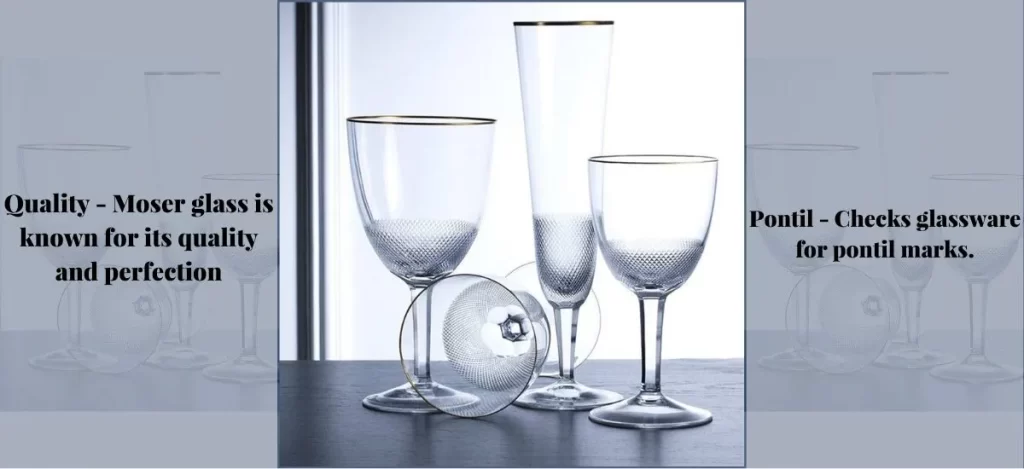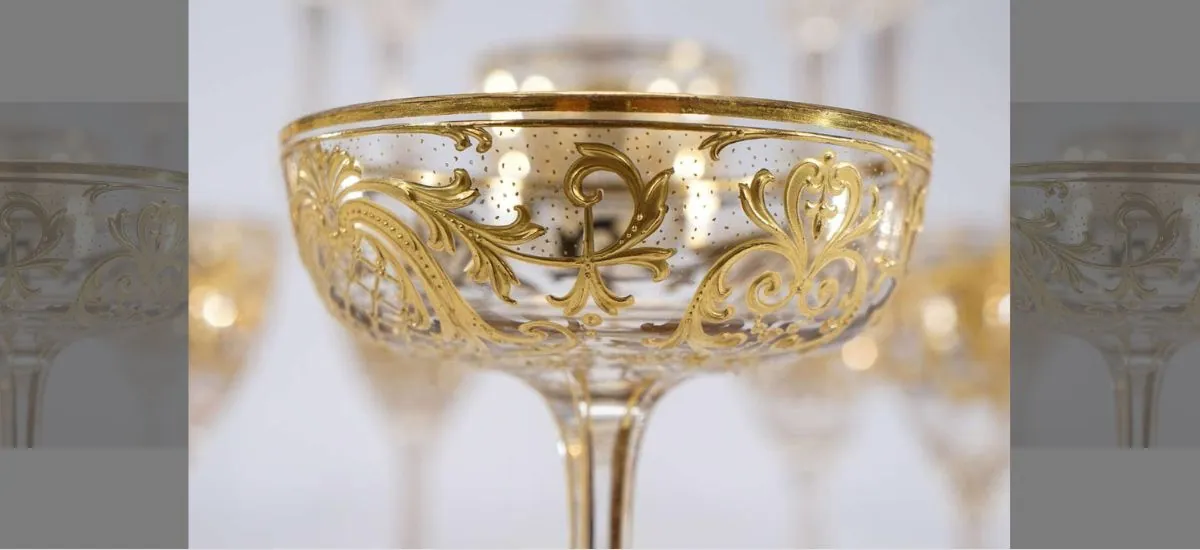Moser glass is the finest collection depicting royalty and richness. This profound vision of art is of an inspiring person, Ludwig Moser, was an inspiring person. A visionary driven by his desire to push the limits of lead-free crystal glass possibilities as far as possible.
An artist who has introduced unique embellishments and unique colors into the world of crystal glass. And he is, above all, a man who has assembled the best glassmakers to create something that has never been seen before.
Its rich collection of colors, styles, and designs makes feel proud if you ever got a chance to have one. But you need to be aware of how to identify Moser glass, the real one.
You May Also Like: Why Are Squishmallows Expensive
A guide to identifying Moser glass

Moser was one of the few Czechoslovak glass companies to sign his products, making his beautiful glassware easily identifiable.
Unfortunately, not all Moser works are signed. However, there are other details you can look for to indicate that the glass is from Moser.
Quality – Moser glass is known for its quality and perfection. Any imperfections such as blisters or warping may indicate that this is not a genuine Moser.
Pontil – Checks glassware for pontil marks. The antique Moser glass is hand blown and has pontil scratches attached to the pole by the glass blower.
Deeply Decorated – The gilded pieces have their decoration deep within the glass. Look for raised edges around gold leaf designs to see if they were added near the surface.
Many products and glass-making techniques from the region have changed little over the years. The shapes, colors, and styles of 100 years ago are still preserved today.
Some of these pieces can easily be mistaken for older ones, especially if they are marked as counterfeit or counterfeit.
The examples in this article show the correct versions of many major brands and how to avoid the most common fakes and fakes.
Guide For: Antique Vases Know Everything
brief history of Moser Glass

The Moser Glass Company was founded by Ludwig Moser in Czechoslovakia in 1857 and focused on producing high-quality sculptural glassware.
In 1873, Moser won a medal at the Vienna World Exhibition, sparking interest in his products. In 1893, Moser expanded his business into a full-service glasswork employing over 400 people.
By 1904 Moser was commissioned to produce glassware for the Austrian court. His continued royal affiliations inspired the company to create the slogan “King of Glass, Glass of Kings”.
Unfortunately, the company’s incredible success did not survive the German invasion during World War II, and many of the company’s employees were sent to concentration camps.
In retaliation, the remaining workers deliberately produced faulty glass for installation in the tank’s windows and filter glass that shattered on impact.
Interestingly, the company was one of only 15 that were granted independence by the communist army after the war, and the glassmaker remains an incredibly profitable glassware maker to this day. increase.
Characteristics and Styles of Moser Glass
Antique Moser glassware comes in a variety of styles, all with different colors and shapes. Here are just a few of the Moser Glass features that collectors are seeing today.
Hoffmann Designs – Created by Johann Hoffmann, one of the company’s early designers, the works are often seen in opaque purple or black colors and feature depictions of animals and female nudes in a flat relief technique. to engrave the motif.
Rich colors – Antique Moser glass was often produced in rich colors such as dark blue, purple, and amber.
Intermediate Gold Glass – This represents the process that Moser developed in the 1890s, in which gold leaf is pressed between two layers of glass and heavily decorated flowers.
Balorak
Barolac is a Czechoslovakian company named Joseph Inwald (c. 1920-1938. Some original pieces are milky and matte.
If marked, the part is usually shown in italics with a barorak. Other works are simply marked Czechoslovakia in carved block letters.
There is some confusion about Barorak’s relationship with British businessman John Jenkins. Inwald glass may have paper labels bearing the names Barolac and Jenkins.
Some people interpret the Barorak label as the Jenkins trade name, but that seems wrong. Inwald seems to have done commissioned work for Jenkins and created certain items specifically for Jenkins.
Also Read: Everything You Need To Know About Antique Woodstove
Czechoslovakia

It didn’t exist until after World War I. Between 1918 and 1938, many pieces of glass were marked “Czechoslovakia”. This mark is used by collectors to date Czech glass made during World War II.
However, most bottles marked Czechoslovakia are rarely traced to a specific company (see Loetz and Kralik for exceptions).
Clark
Wilhelm Kralik Söhne was a major glasswork in the Austrian-Bohemian region of Eastern Europe. Founded in 1815, it produced high-quality art glass until 1933. Kralik’s name does not appear on the glass, but the company used the very distinctive “Czechoslovakia” mark on his circa 1919-1933. This mark appears as a domed acid stamp.
Notice that the two letters O are split in the middle. Bohemian glass experts Robert Truitt and Deborah Truitt estimate that 60-70% of the pieces bearing this mark are Kralik products1. Most authentic marks on Czech glass circa 1918-1938 were stamped with acid or ink, but some were molded or sandblasted.
Until recently, Czech glass counterfeit marks from 1918 to 1938 were generally worthless due to their relatively low prices. However, interest in Czech glass is growing, and counterfeits are on the rise as prices rise.
The best advice to avoid new brands is to not base your purchase decision solely on the brand. Design, color, and construction details are more indicative of age, quality, and Czech origin than the brand. The glazier that bears his name did not belong to Johann Lotz. The iridescent glass known by his name was made by his widow Susannah in his 1851 glass factory.
She named the company “Johann Loetz Witwe” (Widow of Johann Loetz).
The company started out manufacturing household items but turned to art glass in 1879 when Johann’s grandson, Maximilian von Spaun II, took over the management of the company. Around 1900, at the turn of the century, the spelling of the company name changed from Loetz to Loetz. Pieces made for export are usually labeled “Lötz, Austria”.
His Loetz, much more iridescent than Tiffany’s or Steuben’s iridescent glass, was originally unmarked. Before the price of her Loetz began to rise in the 1990s, many of her originally unmarked Loetz pieces had forged signatures from other manufacturers such as Tiffany and Steuben.
Now that Loetz’s prices match or exceed those of other manufacturers, his former Tiffany and Steuben knockoffs are polished and bearing fake Loetz marks.
Some of the less valuable pieces from other manufacturers even had the real original marks removed and fake Loetz marks added.
There are a few simple rules to keep in mind when investigating questionable Loetz marks. First, the original Loetz mark containing the word “Loetz” or “Lötz” was not acid stamped.
Any acid stamp containing the word Loetz or Loetz is fake. Loetz or all original Loetz engravings are stamped on the wheels. A mark made with a diamond pen or electronic pen is almost certainly a fake.
A piece of glass made by Loetz between 1919 and 1939 was labeled Czechoslovakia in acid-embossed letters.
According to Robert and Deborah Truitt1, his two brands in particular – Oval Czechoslovakia and Rectangular Box Czechoslovakia – have about a 90% chance that he is Loetz, although neither Loetz nor his Loetz is acid him.
How to Care for Your Moser Glass

Moser Glass is one of the rarest things that someone can ever have if you have a bit of great luck having this royal antique piece, you need to know about the appropriate method of handling the Moser glass
First of all, like ordinary glass never try to wash it in the dishwasher or use it in the microwave. Clean the Moser glass only with mild detergent.
Place a tea towel in the bottom of the sink before adding water to prevent the Moser glass from chipping or cracking. Dry your work with a soft cloth and store your glassware out of direct sunlight.
If you take good care of your glass, it will become an heirloom that can be passed down for generations.
Glassware Fit for a King or Queen
When it comes to craftsmanship, nothing compares to Moser products. Their antique glassware is worth thousands of dollars and is in the collections of prestigious homes around the world.
Most people don’t have the opportunity to collect Moser glass themselves, so find out if there is a historic building or collection in your area that owns Moser and learn about Moser’s legendary work I can.
Wrap Up
Moser glass is not an ordinary piece of glass, it is the art of vintage days. The company started as a dream but now its rich, royal art of glass become a dream to many people. Crafted with passion and legacy. Even after 160 years, Moser is still ruling the market of legacy and Antiquity. The above article is full of information about Moser. Identifying the Moser glass is the most significant step before having it.
